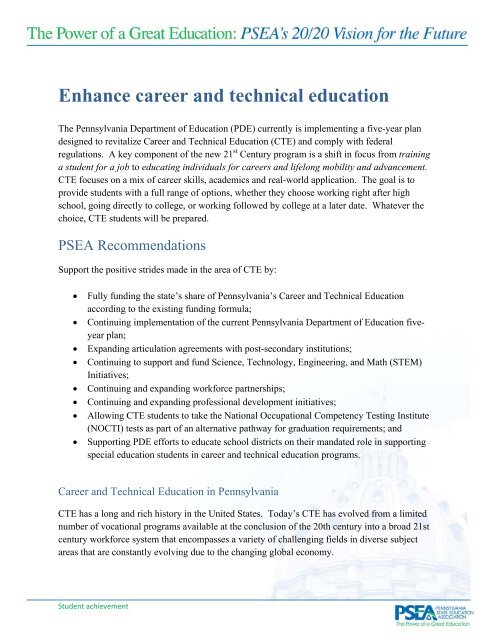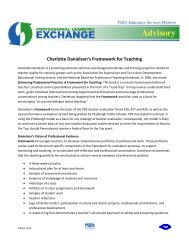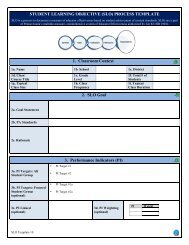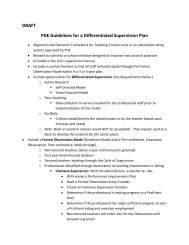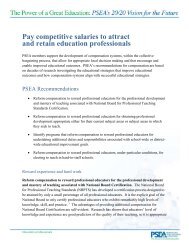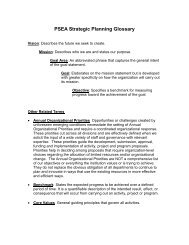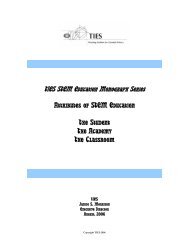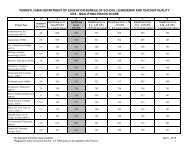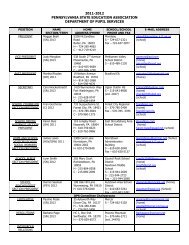Enhance career and technical education - PSEA
Enhance career and technical education - PSEA
Enhance career and technical education - PSEA
You also want an ePaper? Increase the reach of your titles
YUMPU automatically turns print PDFs into web optimized ePapers that Google loves.
<strong>Enhance</strong> <strong>career</strong> <strong>and</strong> <strong>technical</strong> <strong>education</strong><br />
The Pennsylvania Department of Education (PDE) currently is implementing a five-year plan<br />
designed to revitalize Career <strong>and</strong> Technical Education (CTE) <strong>and</strong> comply with federal<br />
regulations. A key component of the new 21 st Century program is a shift in focus from training<br />
a student for a job to educating individuals for <strong>career</strong>s <strong>and</strong> lifelong mobility <strong>and</strong> advancement.<br />
CTE focuses on a mix of <strong>career</strong> skills, academics <strong>and</strong> real-world application. The goal is to<br />
provide students with a full range of options, whether they choose working right after high<br />
school, going directly to college, or working followed by college at a later date. Whatever the<br />
choice, CTE students will be prepared.<br />
<strong>PSEA</strong> Recommendations<br />
Support the positive strides made in the area of CTE by:<br />
• Fully funding the state’s share of Pennsylvania’s Career <strong>and</strong> Technical Education<br />
according to the existing funding formula;<br />
• Continuing implementation of the current Pennsylvania Department of Education fiveyear<br />
plan;<br />
• Exp<strong>and</strong>ing articulation agreements with post-secondary institutions;<br />
• Continuing to support <strong>and</strong> fund Science, Technology, Engineering, <strong>and</strong> Math (STEM)<br />
Initiatives;<br />
• Continuing <strong>and</strong> exp<strong>and</strong>ing workforce partnerships;<br />
• Continuing <strong>and</strong> exp<strong>and</strong>ing professional development initiatives;<br />
• Allowing CTE students to take the National Occupational Competency Testing Institute<br />
(NOCTI) tests as part of an alternative pathway for graduation requirements; <strong>and</strong><br />
• Supporting PDE efforts to educate school districts on their m<strong>and</strong>ated role in supporting<br />
special <strong>education</strong> students in <strong>career</strong> <strong>and</strong> <strong>technical</strong> <strong>education</strong> programs.<br />
Career <strong>and</strong> Technical Education in Pennsylvania<br />
CTE has a long <strong>and</strong> rich history in the United States. Today’s CTE has evolved from a limited<br />
number of vocational programs available at the conclusion of the 20th century into a broad 21st<br />
century workforce system that encompasses a variety of challenging fields in diverse subject<br />
areas that are constantly evolving due to the changing global economy.<br />
Student achievement
Today’s CTE provides students:<br />
• Academic subject matter taught with relevance to the real world;<br />
• Employability skills, from job-related skills to workplace ethics;<br />
• Career pathways that link secondary <strong>and</strong> postsecondary <strong>education</strong>;<br />
• Second-chance <strong>education</strong> <strong>and</strong> training; <strong>and</strong><br />
• Education for additional training <strong>and</strong> degrees, especially related to workplace training,<br />
skills upgrades <strong>and</strong> <strong>career</strong> advancement.<br />
Some facts about Pennsylvania CTE students:<br />
• Students can attend one of 81 Area Vocational Technical Schools (AVTSs), also called<br />
Career <strong>and</strong> Technology Centers (CTC’s) or Technical Schools. In addition, 15<br />
AVTSs/CTCs offer comprehensive full-time programs where students receive both basic<br />
<strong>and</strong> <strong>career</strong> <strong>and</strong> <strong>technical</strong> <strong>education</strong>. There also are many CTE programs that are<br />
delivered in high schools, such as Business Education <strong>and</strong> Agriculture Education.<br />
• According to 2006-2007 data from the U.S. Department of Education (the latest numbers<br />
publicly available), there are more than 200,000 CTE students in Pennsylvania.<br />
• In 2006-2007, 5,418 CTE students earned Industry Approved Certifications.<br />
Funding is declining. <strong>PSEA</strong> is very concerned that, in the last decade, the state subsidy for<br />
vocational <strong>education</strong> has dramatically declined. In the 2009-2010 school year, Pennsylvania<br />
CTE will receive a subsidy allocation that is 70 percent less than is needed to fully fund the<br />
vocational subsidy formula, resulting in districts receiving only a percentage of the funds<br />
necessary to run these programs. With each year of decline, the extra financial burden further<br />
constricts the state’s ability to meet the needs of these students. Funding must start to increase,<br />
or CTE schools <strong>and</strong> programs will be faced with cutbacks in program offerings, materials, tools<br />
<strong>and</strong> supplies, which will have a devastating effect on classroom instruction.<br />
<strong>PSEA</strong> supports exp<strong>and</strong>ing effective programs that focus on real-world needs such as those that:<br />
• Combine at least two years of secondary <strong>education</strong> in a state-approved CTC with the<br />
equivalent of two years of postsecondary <strong>education</strong> (associates degree) or less (certificate<br />
program).<br />
• Align with Pennsylvania Department of Labor <strong>and</strong> Industry-recognized high priority<br />
occupations that are in dem<strong>and</strong> by employers, have higher skill needs, <strong>and</strong> are most likely<br />
to provide family sustaining wages (currently $27,000 for two adults). 1<br />
Student achievement
• Exp<strong>and</strong> STEM (Science, Technology, Engineering <strong>and</strong> Math) Initiative opportunities.<br />
Pennsylvania <strong>and</strong> five other states (Colorado, Hawaii, Minnesota, Ohio, <strong>and</strong> Virginia)<br />
have joined forces with the National Girls Collaborative Project. The goal of this<br />
program is to increase opportunities for women, minorities <strong>and</strong> underdeveloped groups to<br />
enter <strong>career</strong> fields represented by STEM. It partners state agencies, businesses,<br />
secondary <strong>education</strong> <strong>and</strong> higher <strong>education</strong> to provide students with an opportunity to<br />
work with mentors in the business community on real-world problems.<br />
• Include professional development for staff, such as:<br />
o The Career <strong>and</strong> Technical Distinguished School Leader Program, which uses<br />
retired educators <strong>and</strong> administrators as coaches to provide targeted assistance to<br />
the Career <strong>and</strong> Technical Centers to improve student achievement on the 11 th<br />
grade PSSA math/reading assessment <strong>and</strong> to improve student achievement on<br />
end-of-course occupational assessments.<br />
o Training to meet needs of special student populations. PDE estimates that 30<br />
percent of CTE students have IEPs or are from low-income families. A recent<br />
change to Chapter 49 – Teacher Certification regulations of the State Board of<br />
Education will require all CTE teacher certification programs to include three<br />
credits focused on diverse/English language learners <strong>and</strong> six credits focused on<br />
special needs instruction.<br />
o Technical Centers That Work (TCTW) – this program is based on a product of the<br />
Southern Regional Education Board (SREB) High Schools That Work. A<br />
program that has been in existence since 1987, this model is based on 10 researchbased<br />
practices that are proven effective.<br />
o MAX (Motivation, Acquisition <strong>and</strong> eXtension) Teaching with Reading <strong>and</strong><br />
Writing – like TCTW, this is not a new program. With this process, the teacher<br />
facilitates the learning with students being active, rather than passive participants<br />
in the classroom. The students read, think, discuss, <strong>and</strong> write about the content<br />
reinforcing their learning as the teacher guides them through the process.<br />
Some CTE students need alternative pathways to graduation<br />
While all of Pennsylvania’s students have been taking part in the PSSA assessments as required<br />
in part by the Elementary <strong>and</strong> Secondary Education Act (ESEA), CTE students have also been<br />
required by The Carl D. Perkins Vocational <strong>and</strong> Technical Education Act to take a CTE<br />
occupational/skills assessment test. This test, originally contracted to the National Occupational<br />
Competency Testing Institute (NOCTI) is administered to students who are soon to complete<br />
their individual CTE program curriculum. The test is a combination of written <strong>and</strong> practical<br />
Student achievement
(h<strong>and</strong>s on) assessments. The purpose of the test is to evaluate students’ levels of competency in<br />
their areas of study (such as electrical <strong>and</strong> drafting).<br />
Now that Pennsylvania has adopted regulations to allow two routes for students to demonstrate<br />
<strong>education</strong>al competency – Keystone Exams or validated local assessments – <strong>PSEA</strong> believes that<br />
the NOCTI exam should be an additional route for CTE students. Most CTE students<br />
concentrate nearly 50 percent of their 10 th to 12 th grade instructional time in their chosen CTE<br />
curriculum. CTE’s students’ scores on their CTE skills assessments (NOCTI tests) demonstrate<br />
their readiness for the <strong>career</strong>s for which they have prepared. <strong>PSEA</strong> believes those NOCTI scores<br />
should be recognized as an appropriate pathway to graduation for CTE students. If the purpose<br />
of the Keystone Exams is to assist in gauging a student’s readiness, then the NOCTI exams are<br />
the appropriate alternative pathway for CTE students.<br />
1 Glasmeier, Dr. Amy K., <strong>and</strong> The Pennsylvania State University. ( 2009). “Poverty in America - Living Wage Calculator,”<br />
retrieved December 2009, from http://www.livingwage.geog.psu.edu/.<br />
Student achievement<br />
(01/10)


